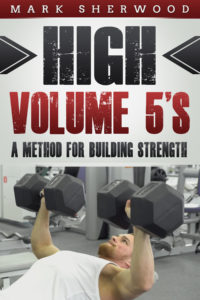 It is hard to deny that there are some people who seem to benefit greatly from high volume training. What is high volume training? I will define it as doing 10 or more sets for a muscle group during a given training session. In my opinion, high volume training is counterproductive for the majority of lifters. I believe that most people will benefit most from doing 2 to 4 warm up sets followed by 2 to 4 work sets for each muscle group during each training session. This should be done in combination with two to three training sessions per week for each muscle group. That being said, not everyone fits into the norm as some people seem to benefit from doing much more than normal.
It is hard to deny that there are some people who seem to benefit greatly from high volume training. What is high volume training? I will define it as doing 10 or more sets for a muscle group during a given training session. In my opinion, high volume training is counterproductive for the majority of lifters. I believe that most people will benefit most from doing 2 to 4 warm up sets followed by 2 to 4 work sets for each muscle group during each training session. This should be done in combination with two to three training sessions per week for each muscle group. That being said, not everyone fits into the norm as some people seem to benefit from doing much more than normal.
Even before steroids made their way into the weight training scene, there were bodybuilders who did tons of sets and reps to develop amazing physiques. Four of these lifters are listed and discussed below:
Bill Pearl trained each muscle group with 20 sets per workout and trained each muscle group three times per week (that’s 60 sets per week for each muscle group).
Chuck often did at least 20 sets per muscle group and trained each muscle group 3 times per week.
Bob Gajda regularly did at least 20 sets per muscle group and more or less trained his whole body every day using what is commonly referred to as peripheral heart action training or PHA. This basically amounts to a form of circuit training. Of all the elite bodybuilders I know of, it appears that Bob used the highest weekly training volume of any of them.
Leroy Colbert is considered to be the first bodybuilder to develop arms that measured over 20 inches. He did about 18 sets per training session for both his biceps and triceps.
You can learn more about how each bodybuilder trained by simply clicking on their names.
Work Your Way Up To It
If you have a chance to read the advice that these bodybuilders offer, they will stress the importance of working up to high volume training. Bill Pearl probably offers the most accessible training advice and outlines a program that takes 20 months to work up to. Those who follow his program all the way to the end will be doing the type of high volume training that he did. I believe that one of the reasons that high volume training often fails is because people don’t work up to it and jump into it too quickly. They burnout and figure that high volume training doesn’t work. If high volume training is going to work for you, you must take your time to work your way into it.
Don’t Train To Failure
Of the four lifters I listed including; Bill Pearl, Chuck Sipes, Bob Gajda, and Leroy Colbert, three of them emphasize their personal belief that it is not good to train to failure. They all warn others not to push their sets to failure.
Chuck Sipes Included High Intensity Training
Chuck Sipes is the exception among high volume lifters before steroids because he would train to failure on some of his sets. Chuck even did strip sets, or drop sets at times. This simply means that he would push a set to failure and immediately strip weight off the bar in order to do another set as quickly as possible. This would be repeated two or three times with little to no rest between sets before stopping.
How To Perform Drop Sets
Chuck Sipes Was Super Human
Chuck Sipes seemed to be the most super human among others who also seem to be super human in terms of their ability to benefit from high volume training. Many have tried to imitate Chuck’s training only to wilt and disintegrate under the high-volume work load he thrived on. I tend to agree with the other three lifters who warned lifters to always leave a couple reps in the tank and refrain from pushing sets to failure; especially when using a high volume training program.
How to Work Up To High Volume Training
I believe that most lifters will do best with a normal range of training volume. What is normal? It basically means to perform 2 to 4 warm up sets followed by 2 to 4 work sets for each muscle group two to three times per week. As long as the normal range of volume works, there is no need to change. However, if it stops working, you may want to try some higher volume training to see if it seems to be beneficial for your individual physiology.
My advice for experimenting with high volume training is to follow a 4 – step program.
Step 1: Two Series of 12 – 10 – 8 – 6 for a total of 8 sets
Step 1 begins with choosing two exercises for each muscle group and using a 12 – 10 – 8 – 6 pyramid procedure for each exercise. This will amount to 8 sets for each muscle group. As an example of this procedure, you can choose bench presses and incline dumbbell presses for chest and perform the following sets and reps for each exercise as follows:
1 set x 12 reps (Use a weight that allows 25 reps, but only do 12 reps)
1 set x 10 reps (Use a weight that allows 18 reps, but only do 10 reps)
1 set x 8 reps (Use a weight that allows 12 reps, but only do 8 reps)
1 set x 6 reps (Leave 2 reps in the tank)
Try the workout listed above for one month.
Step 2: Two Series of 12 – 10 – 8 – 6 – 6 for a total of 10 sets
If you feel like you are recovering from 8 sets per muscle group, you can add one more set of 6 reps to each exercise. This will amount to a series of 12 – 10 – 8 – 6 – 6 for each exercise and will equal ten total sets. This workout is listed below:
Complete the following sets and reps for bench presses and incline dumbbell presses:
1 set x 12 reps (Use a weight that allows 25 reps, but only do 12 reps)
1 set x 10 reps (Use a weight that allows 18 reps, but only do 10 reps)
1 set x 8 reps (Use a weight that allows 12 reps, but only do 8 reps)
2 set x 6 reps (Leave 2 reps in the tank)
Perform the workout listed above for six weeks. If you are still able to recover from the extra sets, you can advance to step 3 and try adding more.
Step 3: Three series of 12 – 10 – 8 – 6 for 12 total Sets
Those who want to add more sets can do so by advancing to three exercises including, bench presses, incline dumbbell presses, and flat dumbbell presses using the 12 – 10 – 8 – 6 pyramid for each exercise. This will amount to 12 sets for each muscle group. Do this workout for at least six weeks before deciding whether or not you can handle more.
Still think you can handle more training volume? If so, advance to step 4.
Step 4: Three series of 12 – 10 – 8 – 6 – 6 for 15 total sets
For step 4, you will basically start where you left off with the same sets and reps for the same three exercises, but you will follow this six-week plan:
Add one more set of 6 reps to bench presses during weeks 1 and 2,
Add an additional set of 6 reps to incline dumbbell presses during weeks 3 and 4,
Add an additional set of six reps to flat dumbbell presses during weeks 5 and 6.
If you are still able to handle the increase in volume, you will be doing a total of 15 sets. It is possible that there are some people who can still benefit from more. If you are one of these rare people, advance to step 5.
Step 5: Four series of 12 – 10 – 8 – 6 for a total of 16 sets
For step 5, you must add on a fourth exercise (I would suggest cable crossovers or incline dumbbell flies) and perform a 12 – 10 – 8 – 6 pyramid for each exercise. This would amount to 16 total sets. Do 16 sets for one month. If you seem to benefit from the added volume, proceed to step 6, which is the last step for those who benefit from high volume training.
Step 6: Four series of 12 – 10 – 8 – 6 – 6 for a total of 20 sets
For step 6, you will add on one set of 6 reps to one of the exercises every month. Keep repeating this for four months in order to reach the point where you are doing a five set pyramid consisting of 12 – 10 – 8 – 6 – 6 for all four exercises for a total of 20 sets for your chest. Twenty sets would be the maximum limit that I suggest. This could be done once, twice, or three times per week for each muscle group.
Remember, the ability to benefit from high volume training is somewhat rare, but it is obvious that some people respond well to high volume training. Even if you are a super responder to high volume training, it is likely that you will still need to work your way up to it over time in order for it to work. If you are one of those who is going to respond well to high volume training, the only way to know is to try it out, which is why I suggest following the guidelines in this article as it will enable you to work your way up to high volume training without burning out before you ever get a chance to see if it really works for you or not. If you find that you respond well to high volume training, you can learn from others who have thrived on high volume training and try some of their training methods. Some resources are listed below to help you do this. Best of training to you.
German Volume Training
Boris Sheiko’s high volume powerlifting program written
Boris Sheiko’s high volume powerlifting program video version
Click on the book cover to read the following book:

